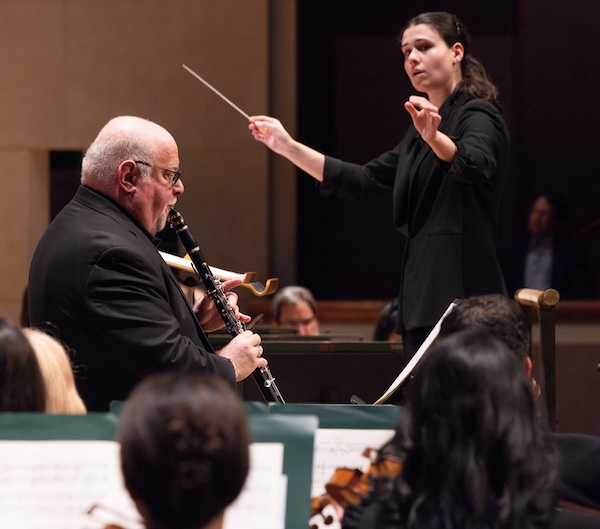Performances
CMSFW ideally balances French rarities and Dvořák favorite
The Chamber Music Society of Fort Worth included works by Gabriel […]
DSO, Alsop present elegiac premiere alongside Brahms and Strauss
Guest conductor Marin Alsop led the Dallas Symphony Orchestra Friday night […]
Soprano Winters shines brightly in HGO’s Puccini trilogy
Alongside its time-honored mission of commissioning and premiering new works, Houston […]
Latin-infused DSO program mixes populist Americana with somber premiere
The Dallas Symphony Orchestra under Fabio Luisi offered a stirring program […]
Hermitage Piano Trio serves up a diverting program of Spanish music for CMSFW
The Hermitage Piano Trio presented a program of mostly Spanish music on […]
Articles
Critic’s Choice
Music of Haydn and Mahler. Dallas Symphony Orchestra/Fabio Luisi. October 2-5 […]
Critic’s Choice for 2024-25
Tate: Woodland Songs. Dover Quartet. Sept. 17 in Houston, Oct. 19 in […]
Concert review
Samuels-Shragg makes impressive debut in challenging DSO program

A family emergency forced Fabio Luisi to cede the podium at the Dallas Symphony Orchestra’s concert on Thursday night. The leadership transition went smoothly with assistant conductor Shira Samuels-Shragg making her subscription series debut.
The orchestra responded well to her understated direction in a pair of orchestral favorites as well as, significantly, a pair of world premieres. Both composers were present to offer introductions to their pieces.
The concert opened with Beethoven’s Leonore Overture No. 3. Samuels-Shragg led buoyant strings in the principal theme. Responding sensitively to the conductor, the ensemble’s playing throughout the piece was splendid with David Buck’s flute solos a standout and Stuart Stephenson’s trumpet solo (from the upper balcony) providing a memorable peak.
Jonathan Cziner’s Concerto for Clarinet was heard in its world premiere, featuring DSO principal Gregory Raden. The composer explained how the soloist acts in some ways as a Jewish cantor, guiding the orchestra through symbolic Hebrew practices of reacting stoically to calamity and eventually embracing joy.
The first movement’s ethereal opening highlighted tam-tam and airy upper strings, with orchestra bells adding to the plush sonorities, underpinning the solo clarinet passages. Raden’s tone was rich and warm across all registers. Cziner incorporates smooth, masterful transitions between his thematic ideas. Harp attacks effectively punctuated some of the quicker motives, as the piece built toward larger, darker textures before subsiding.
The central movement began with a lengthy cadenza, enriched by Raden’s controlled, melancholy timbre and subtle flourishes throughout his range. The ensemble sonority gradually thickened as brass and winds entered for first time, displaying the composer’s wide timbral palette of colors.
The finale captured the festive Klezmer spirit of secular celebrations in Yiddish communities, incorporating a musical language associated with Eastern European and Roma rhythms and scale patterns. Evocative short solos by concertmaster Nathan Olson and Stephenson were also idiomatic to the style.
After intermission, the second premiere was heard—Moni Jasmine Guo’s the sound of where I came from 乡音.
The single-movement opened with bright, monumental orchestrations. Touches from the composer’s native China included woodblocks, cymbals, and pentatonic themes. Her lush, flowing gestures migrated across the sections of the orchestra with the bassoon playing particularly impressive.
Trumpet and trombone engaged in brief motivic dialogs. Guo based these and other themes rhythmically on her childhood memories of calling back and forth affectionately with her grandmother. The piece also featured rich woodwind and brass tone clusters, as well as solos and duos for various combinations of the string principals.
Mozart’s Symphony No. 40 closed the evening in a performance characterized by Samuels-Shragg’s brisk tempi. The orchestra mustered sufficient heft to give proper gravitas to development sections in the outer movements.
In the Andante, Samuels-Shragg’s pace resembled a lilting trot more than a stroll. Here the strings sounded stiff, lacking shading, while winds and horns were appropriately light. The quick tempo of the third movement enhanced the minuet’s dance aesthetic but obscured some of the most interesting counterpoint and metrical intricacies.
The vibrant energy of the final movement also lent it a danceable feeling. Mark Debski’s oboe solos were focused, while Samuels-Shragg led the ensemble through a taut, mildly turbulent development.
Overall the DSO’s performances were outstandingly cohesive under Samuels-Shragg’s direction. The concert was also another success in the DSO’s commendable series of elite premiere performances of the newest musical offerings.
Calendar
January 1, 2026
Bach Society Houston
James Bobb, organist
6 p.m. Christ […]
News
Aristo Sham takes the Gold at Cliburn Competition
In a concluding ceremony Saturday evening, Aristo Sham, 29, of Hong Kong, […]
Texas Classical Review wants you!
Texas Classical Review is looking for concert reviewers in the Dallas-Fort […]
